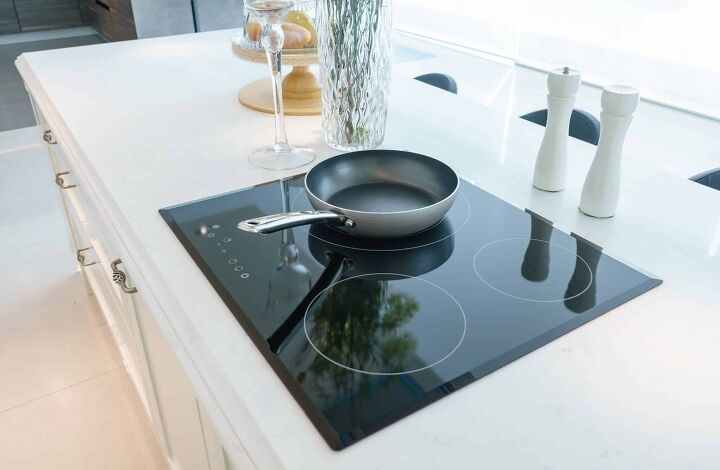What Are The Pros and Cons of Induction Cooktops?

Ever since the discovery of fire, humans have been eager to cook using it. As time passed, cooking techniques have become increasingly more efficient and sophisticated, in addition to more compact and portable.
The pros of induction cooktops include fast cooking time, safety, low maintenance cleaning, and durability. Induction cooktops have cons and that includes their price, loud operation, reliance on power, and special cookware. You can use an induction cooktop for years, so their high price is worth the investment.
The science used in induction cooktops has been perfected over the last 50 or so years and while this may be your first time hearing about them, they are not a new invention. They are very popular among those who seek to upgrade their existing electric glass cooktop or are looking for more energy-efficient alternatives.
Do You Need Appliance Installation or Replacement?
Get free, zero-commitment quotes from pro contractors near you.

What Is Induction Cooking and How Does it Work?
The term “induction” refers to a particular method for heat generation. To put things into perspective, a conventional electric stove uses radiant heat to cook food and your microwave has micro, or tiny energy waves to achieve a similar heating effect. On the other hand, induction cooking involves electromagnetism that cooks your food inside of a pan or pot.
An induction cooktop contains coils that are constructed of a magnetic material. As the current passes through the coil, it creates a magnetic field that transfers to the pan above, and only the pan. Consequently, only the pan and its fillings will heat up and neither the surrounding air nor the cooktop will experience any heat whatsoever. When you remove the pan, the reaction stops and the surface of the cooktop will be cool to the touch.
The key to making an induction cooktop work is having the correct cookware. In order to generate the electromagnetic reaction that will cook your food, you need to use a magnetic pot or pan. Some options for cookware materials include magnetic stainless steel or cast iron.
Quick Tip: You can test if your pot or pan will work on an induction cooktop by simply seeing if a refrigerate magnet sticks to it. If the magnet sticks, your cookware can be used on an induction cooktop.
The Pros of Using an Induction Cooktop
The following are the payoffs that you can expect when you make the switch over to induction cooking.
1. Induction cooking is fast.
Cooking with an induction cooktop allows for a very responsible and precise experience. Since the heat is transferred directly into the pan, there is very little heat loss. Also, induction is instantaneous and the wait-time for heating up a pot or pan is significantly reduced. For example, if you’re heating up oil in a pan, you’ll want to have the ingredients on hand as it will be hot in merely seconds.
The heat adjustment that comes with induction cooking is very quick and extremely precise, setting this method of cooking apart from both gas and electric. Although there may be some learning curve when you purchase a new induction cooktop, the speed and efficiency are well worth it.
2. Induction cooking is the most sustainable cooking method.
Since induction cooking is a much faster method, it uses far less energy than its electric or gas counterparts. It is actually considered the most efficient way to cook. This is due to the fact that the cooktop only heats up the pan and allows for very little, if any, heat loss.
In fact, all the heat will be in the pot or pan, with none coming from the cooktop itself. Not only does this equate to less energy usage overall you will likely notice a huge dip in your utility bills and the total energy savings will add up over time.
3. Induction cooking is much safer than gas or electric.
Safety is by the far the biggest pro associated with induction cooktops. In general, induction cooking is fundamentally safer than other cooking methods because the burners themselves do not get hot, the pan does.
As opposed to gas or electric stovetops, with induction cooktops you can place a paper towel or dish rag close to the pan and will not create any potential fire hazards. Once the pan is removed from the cooktop, the surface will no longer be hot. With no heat on the physical cooking surface, this is an ideal choice for when you have children or pets in the house.
Additionally, induction cooktops have a variety of additional safety features including auto shut off, pot sensors, timers, and control locks, ensuring the safest cooking environment possible. With these auto shut-off features, there is less of a risk of you ever accidentally leaving the stove on when you’re finished cooking.
Plus, no gas-provided flame and no gas released into the air, means that won’t have any potential carbon monoxide risks.
4. Induction cooktops have a very appealing look.
The smooth glass surface and, most often, lack of knobs, induction cooktops can be an attractive addition to your kitchen. They blend seamlessly into any countertop and can make the space seem larger with their lack of controls and a raised surface.
Induction cooktops are sleek, modern and will complement just about any décor style.
5. Induction cooktops are easy to clean and messes are rare.
The clean up after cooking on an induction surface is a breeze. Since the surface doesn’t get hot, food splatters will not cook or adhere making them easy to be wiped off. Induction cooktops are often one seamless piece and do not require cleaning of any knobs or burners.
Additionally, because of the safe nature of this appliance, you can place rags or paper towels on the surface for easy cleanup. Cleaning an induction cooktop is as easy a quick wipe down after you’ve finished cooking.
The Cons of Using an Induction Cooktop
Like anything, there are some cons associated with induction cooktops. While the drawbacks are few, they should still be considered and understood.
1. Specialized cookware is required for induction cooktops.
The higher quality cookware that is required to properly conduct the electrical current may be an added investment. Simply put, you will not be able to cook using an induction cooktop if you do not have the necessary cooking materials. To be used on an induction cooktop, the cookware must be steel. Stainless steel performs best and cast iron is another great option.
In order for cookware to be compatible with induction cooktops, it must contain iron particles. These iron particles activate and produce heat when they come into contact with induction heaters. If you’re unsure whether or not your current pots and pans are “induction safe,” perform the magnet test. Simply try to attach a magnet to the bottom of the cookware. If it sticks, it can be used with an induction cooktop.
Another tool that you may have to replace is your digital meat thermometer. The magnetic field of induction cooktops is known to interfere with these digital devices. So, you’ll need to get an old-fashioned, analog thermometer if you have an induction cooktop, which may be an additional expense if you don’t already have one.
2. You cannot cook on an induction cooktop if you lose power.
Unlike gas cooktops, if the power goes out in your home you cannot use your induction cooktop. They require electric power in order to function and you won’t be able to make a warm meal without access to electricity.
3. Induction cooktops are an investment.
In general, you can expect to pay more for an induction cooktop than a similarly-sized traditional stovetop. However, now that they are becoming increasingly popular among homeowners and the demand is up, more manufacturers are entering the market.
The technology is beginning to grow in accessibility and there are a lot of price points that are competitive with electric and gas cooktops.
4. Induction cooktops are more prone to scratching.
Gas and electric ranges generally come with a grate or heating element that is able to withstand a significant amount of wear and tear. Induction cooktops, on the other hand, are made of a smooth glass that tends to scratch easily.
Manufacturers of induction cooktops recommend to use cookware with smooth, clean bottoms, and avoid sliding them around on the surface. You should also stay away from abrasive cleaning methods and materials on an induction range.
5. Induction cooktops are not silent.
According to some induction cooktop owners, they make a slight hum or buzz during operation. Some even claim that the sound is louder at higher settings. Though, it should be noted that this may be due to the particular cookware that is used and not the cooktop itself. You can expect heavier pans, such as cast iron, to produce more noise than lighter stainless steel cookware.
6. Induction cooktops may overcook your food.
Since induction cooktops heat food much faster than conventional cooking methods, they may overcook your food at first. To avoid this, it’s important to remember that your cookware doesn’t need to preheat as long and a lower heat setting is best for maintaining the temperature of the food. While there is a slight learning curve to these appliances, the trade-off is a fast overall cook time.
7. Heating element sometimes shuts off without warning.
Speaking of learning curve, it’s crucial that the appropriate size cookware is placed in the dead center of an induction cooktops heating element in order for it to activate. The pot or pan cannot be off-center, too small, or unstable. So, in most cases, flat-bottomed cookware is ideal.
Although most induction cooktops come with a lock setting that lets the user shift and move the pan around while cooking, many find that the this isn’t very effective. In fact, some claim that the heating elements are prone to cutting off prematurely or shutting down without any warning.
Do You Need Appliance Installation or Replacement?
Get free, zero-commitment quotes from pro contractors near you.

Are Induction Cooktops Worth It?
Believe it or not, induction cooktops have been widely available since the mid-2000s and many who own them love them. Despite all of the disadvantages stacked against them, are induction cooktops worth it? Although these appliances can take some getting used to and require specialized cookware to function, the temperature control they offer is unbeatable.
When you compare induction cooktops to electric or gas, they cook food quicker, adapt better to temperature changes, and take very little time to cool down. Induction cooktops are also very easy to clean, look very sleek and attractive in any space, and are much safer than convectional electric or gas ranges.
If you’re able to live with the slight noise, tendency to scratch, high price point, lack of operation in the instance of a power outage, and the specialized cookware required, induction cooktops are an excellent choice. By understanding what you get and what you give up when you opt for an induction cooktop, you can make an informed decision about what is best for you.

Jessica considers herself a home improvement and design enthusiast. She grew up surrounded by constant home improvement projects and owes most of what she knows to helping her dad renovate her childhood home. Being a Los Angeles resident, Jessica spends a lot of her time looking for her next DIY project and sharing her love for home design.
More by Jessica Stone



























